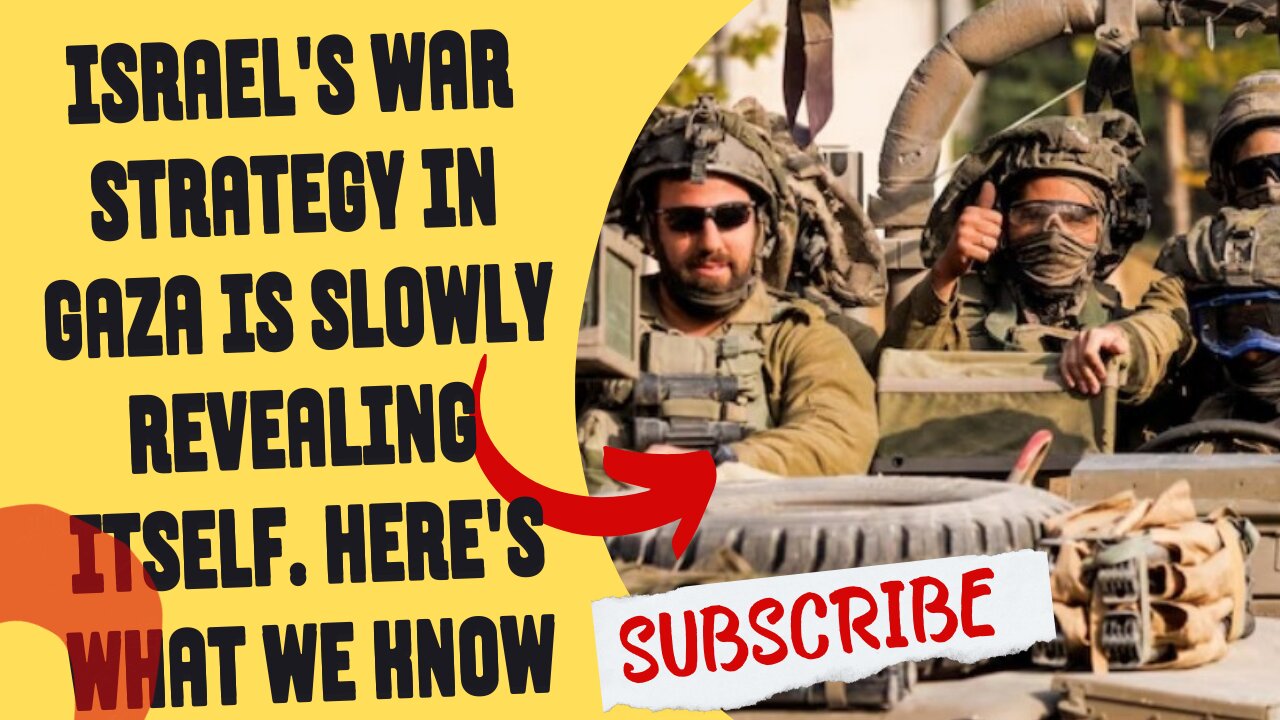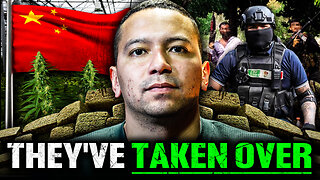Premium Only Content

Israel's war strategy in Gaza is slowly revealing itself. Here's what we know
Israel's war strategy in Gaza is slowly revealing itself. Here's what we know
When Israel launched its military response to the deadly Hamas-led attack on October 7, many expected a swift ground invasion of Gaza that would rival America's shock-and-awe tactics on the battlefield.
But three weeks after the massacre, Israel's secretive military strategy, Operation Swords of Iron, is slowly starting to reveal itself.
The last few days saw a dramatic escalation in Israel's activities in Gaza.
There was a near-total communications blackout in the strip, heavy aerial bombardment, and a ground incursion in the north — albeit in a limited capacity.
Troops conducted a night-time raid to destroy "numerous terrorist cells, infrastructure and anti-tank missile launch posts" before returning to home soil, according to the Israel Defence Force (IDF).
And on Monday, the Israeli military pushed towards the heart of the enclave, with tanks spotted on the outskirts of Gaza City.
Witnesses say they stayed about an hour before retreating from the area.
"This is the second stage of the war whose goals are clear: to destroy Hamas's governing and military capabilities and to bring the hostages home," Israeli Prime Minister Benjamin Netanyahu said.
"We are only at the start. We will destroy the enemy above ground and below ground."
Israeli officials are referring to this new phase of the war as a "ground operation" rather than an invasion.
Mr Netanyahu has also warned Israelis to expect a "long and difficult" fight, indicating that this war could last months, rather than weeks.
Whether this is a precursor to a full-scale ground invasion or an indication that Israel plans to push into Gaza metre by metre, the three main objectives of Operation Swords of Iron are becoming clear.
LIVE UPDATES: For all the latest news about the Israel-Gaza war follow our blog.
Step 1: Pressing into Gaza slowly
Israel has put boots on the ground in Gaza before, occupying the coastal enclave from 1967 to 2005.
A large-scale invasion of the territory in 2014 turned into a gruesome urban battle that left 2,251 Palestinians and 73 Israelis dead, according to the UN Office for the Coordination of Humanitarian Affairs.
This time, Israel is not rushing in.
Grainy footage released by the IDF of their night-time raid in northern Gaza shows Israel's tanks and armoured bulldozers engaging in what's known as a "shaping operation", clearing obstacles so that it's safer for troops to follow.
They will likely … go building-to-building to search for and destroy Hamas's military capability, including command and control, weapons caches, key leaders, and Hamas fighters who decide to stay and fight," said Alex Plitsas, a nonresident senior fellow with the Atlantic Council's Middle East Programs' N7 Initiative.
"This operation will likely take months if Netanyahu's goal is to be achieved and will be a bloody, difficult fight."
Israel has plenty of reasons to enter Gaza slowly.
Hamas has trained for urban combat for years and has built a network of underground tunnels that move fighters and weapons undetected.
During the raid at the weekend, the IDF said it killed a group of Hamas militants that emerged from a tunnel near the Erez border crossing.
"The war in 2014 was really a wake-up call for Israel," said Dr Daphné Richemond-Barak, an expert on underground warfare who teaches at Reichman University in Israel.
It created special units, with soldiers that are trained specifically to neutralise, destroy, and fight in tunnels. And so this is Israel trying to face this threat in a more appropriate way than it did in 2014."
This slow creep into Gaza is aimed at reducing the number of Israeli casualties, and also dissuading Iranian proxy group Hezbollah from becoming involved in the conflict.
But the tactic comes with its own risks.
It gives Hamas more time to lay traps and prepare for the advance of Israeli troops as they push further south.
And it comes at a devastating cost to the people of Gaza.
More than 8,000 Palestinians have died since the beginning of the conflict, according to the Gaza Health Ministry.
If the death toll continues to climb and conditions in the enclave worsen, experts say Israel's allies may begin to exert pressure to end the conflict.
"As the casualties and devastation grow, the international pressure on Israel will mount for a ceasefire — but the appetite in Israel for a full-scale operation is so far unwavering," said Carmiel Arbit, a nonresident senior fellow at the Atlantic Council's Scowcroft Middle East Security Initiative.
Step 2: Hopefully freeing some hostages
Israel's Minster of Defence Yoav Gallant met with some of the hostages' families to reassure them that freeing their loved ones was still an integral part of the military's strategy.
"Returning the hostages and tracking missing Israelis is a mission of utmost importance. I have two goals: returning those who were kidnapped and winning this war. All the rest is less important right now," he said.
We have gathered the best people from all branches of the defence establishment, for this specific mission."
But it remains unclear exactly how the IDF will save the hostages when they are beyond their reach, deep underground in the Hamas tunnel network.
That likely leaves only diplomatic solutions or a hostage exchange.
The last three weeks have been unimaginable for the families of the estimated 230 hostages
Many members of the forum are now calling for what's known in Israel as an "everyone for everyone" deal.
Hamas has said it would be willing to release the 230 hostages — but only if Israel freed every single Palestinian currently being held in its prisons.
A spokesman for the IDF dismissed the offer as "psychological terror" by Hamas.
That leaves the families of hostages unsure what happens next.
Yonatan Zeigen's 74-year-old mother Vivian Silver is believed to be among those currently being held captive by Hamas.
"I'm afraid because it seems like the military option is more prevalent for the government and I fear that it will harm the hostages," he said.
"I do fear she's more at risk because soldiers are not surgeons. War is chaotic and from the side of Hamas, they took them as leverage and if they lose that leverage, they don't have use for them anymore, so it seems to me that she is more at risk.
"I just want her back."
Step 3: Eventually cutting ties with Gaza forever
For about a decade, Israel has adopted a military strategy in Gaza often referred to as "mowing the grass" — treating Hamas and its weapons as a weed that occasionally needs to be hacked back.
But the attack on October 7 has dramatically changed Israel's perception of the militant group.
The IDF says the main aim of this war in Gaza is to eliminate Hamas — a lofty goal it may not be able to achieve — before cutting ties with the enclave forever.
The third step [of this war] will be the creation of a new security regime in the Gaza Strip, the removal of Israel's responsibility for day-to-day life in the Gaza Strip, and the creation of a new security reality for the citizens of Israel and the residents of the [area surrounding Gaza]," Defence Minister Yoav Gallant said earlier this month.
Before this conflict, Israel supplied Gaza with most of its energy needs and allowed some people to cross the border to work.
In the days after the October 7 attack, Israel ordered a complete siege, blocking all food, fuel, and other supplies from entering the region.
"People in Gaza are dying, they are not only dying from bombs and strikes. Soon many more will die from the consequences of [the] siege," said Philippe Lazzarini, head of the UN's agency for Palestinian refugees.
How Israel would sever links with Gaza remains unclear.
If they decapitated Hamas's leadership and immediately withdrew, surviving members would likely fill the power vacuum and rebuild the group — or start something new.
Israel might also try to reinstall the Palestinian Authority (PA), a governing body that was ousted from Gaza in a 2007 Hamas coup.
But PA Prime Minister Mohammad Shtayyeh told the Guardian his group would not return without the "framework of a two-state solution".
"There's no going back to the status quo as it stood on October 6," US President Joe Biden said this week.
"It also means that when this crisis is over, there has to be a vision of what comes next, and in our view, it has to be a two-state solution."
-
 LIVE
LIVE
Major League Fishing
4 days agoLIVE! - Bass Pro Tour: Stage 3 - Day 4
1,438 watching -
 1:05:28
1:05:28
Sports Wars
3 hours agoLebron GOES OFF Over Bronny Hate, Pereira LOSES Belt To Ankalaev At UFC 313, Xavier Worthy Arrested
3.85K4 -
 10:27
10:27
Tactical Advisor
1 day agoDMR or SPR for Civilian Use?
25.3K5 -
 8:21
8:21
DEADBUGsays
1 day agoThe Crossbow Killer
12.1K8 -
 8:40
8:40
Tundra Tactical
20 hours ago $5.53 earnedThe Executive Order Wishlist.
25.1K2 -
 7:22:52
7:22:52
SpartakusLIVE
19 hours agoSaturday SPARTOON Solos to Start || Duos w/ StevieT Later
104K2 -
 28:40
28:40
SLS - Street League Skateboarding
8 days agoTOP MOMENTS IN WOMEN’S SLS HISTORY! ALL THE 9’s - Rayssa Leal, Leticia Bufoni, Chloe Covell & more…
71.8K11 -
 2:03:03
2:03:03
The Connect: With Johnny Mitchell
16 hours ago $3.88 earnedHow Mexican & Chinese Cartels Control Illegal Marijuana Cultivation In America Using SLAVE Labor
20.2K4 -
 14:46
14:46
Mrgunsngear
17 hours ago $2.21 earnedPrimary Arms GLx 1x Prism With ACSS Reticle Review
26K8 -
 22:37
22:37
Degenerate Plays
17 hours ago $0.36 earnedI'm A Psychic Now - Elden Ring : Part 73
14.2K